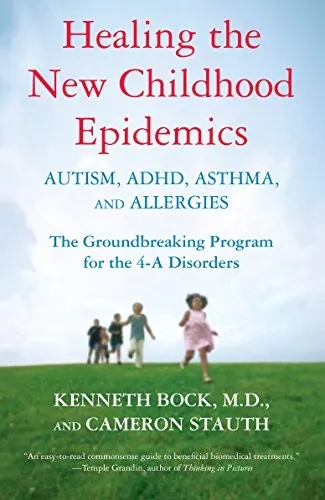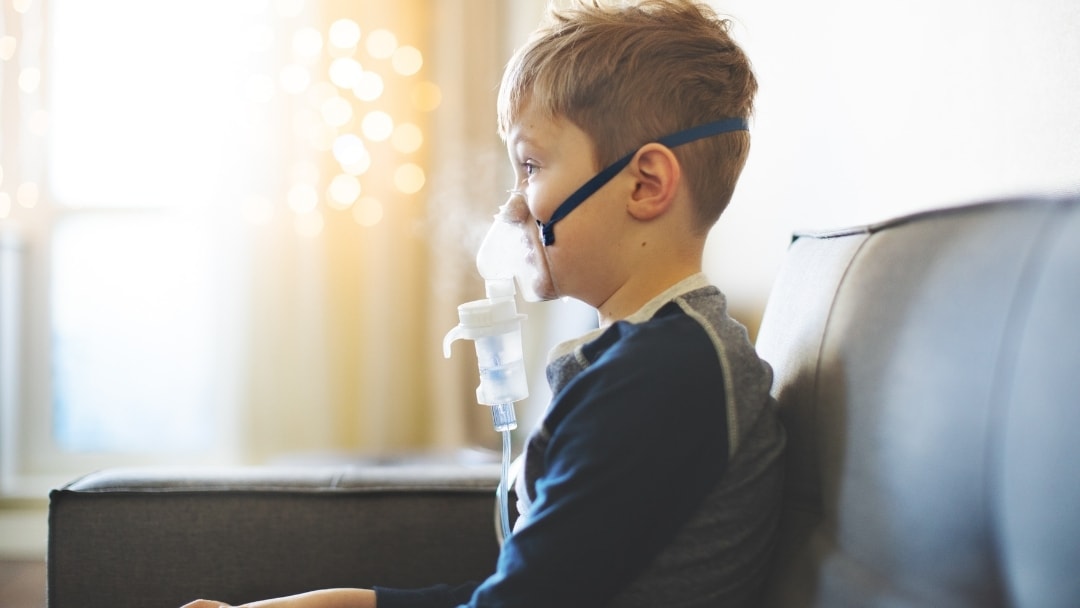What Is Asthma?
Asthma is a chronic respiratory condition that inflames and narrows the airways making it difficult for a child to breathe. It can cause shortness of breath and reoccurring periods of a musical high-pitched whistling sound as the child breathes, known as “wheezing”. Coughing usually accompanies the breathing difficulties at night or in the early morning.
An asthma attack can be triggered by an allergic reaction or some other form of sensitivity such as pollen, dry leaves, cats, smoke, air pollution, grass, dust mites and burning wood. Today, asthma is one of the most common long-term respiratory conditions found among children.
What Your Doctor May Tell You About Asthma
Your pediatrician may tell you that your child has had many of the risk factors for developing asthma such as:
- Eczema
- Low birth weight
- Caesarean section
- Early antibiotic usage
- Tylenol usage
- Frequent respiratory infections
- Family history of autoimmune diseases, allergies and asthma
- Second-hand smoke
- Poor hygiene
- Allergies
Your child may be given an inhaler with steroid medication for long-term control, prevention and management of acute asthma attacks. An inhaler is a device with a holding chamber to ensure that the medication reaches the lungs. Alternatively, your child may be given a nebulizer which is a machine that includes compressor tubing and a mask to deliver the medication. These steroid medications do slow down a child’s growth and are also addictive with devastating side effects from long-term usage, but your pediatrician will tell you this outweighs the risk of not being able to breathe.
If medications are unable to help your child, your pediatrician may suggest seeing a specialist such as an allergist or immunologist. The allergist may administer allergy shots (immunotherapy) to help with the allergies triggering the asthma attacks.
In certain cases, many doctors will suggest having an adenotonsillectomy, which is the surgical remove of the child’s adenoids and tonsils. Pediatricians will tell you that this procedure in most cases will eventually stop asthma completely.
Another Way to Think About Asthma
Asthma is an indication that the immune system is compromised and there are underlying imbalances that have resulted in inflammation in the bronchial tubes which needs to be identified and addressed.
One of the biggest culprits of asthma is dairy/casein. Sometimes, eliminating all dairy can have a dramatic effect on eliminating symptoms of asthma. There could also be other food allergens triggering asthma such as wheat, gluten, and eggs and airborne allergens such as mold, pet dander, pollen and dust. In addition to the elimination process of these allergens, dietary changes are necessary to treat and heal the gastrointestinal issues (leaky gut syndrome) and the microbiome.
Nutritional supplementation may also be used to improve the immune system and reduce the inflammation in the lungs. A key supplement often times overlooked is sulfur, a very important mineral needed for detoxification of the liver, elimination of allergies and strengthening the lungs. If a child has high levels of toxicity such as yeast, heavy metals, and other pathogens, then it is probably best to apply sulfur in a transdermal form or just give Epsom salt baths instead of using an oral supplement.
Detoxifying the body from yeast overgrowth, fungus, Candida, heavy metals, parasites, viruses, bacteria and other pathogens can collectively improve the immune system so that the number of food and airborne allergies are eliminated.
Identifying underlying imbalances, eliminating toxic overload and strengthening the immune system can eliminate allergies, reduce the inflammation in the lungs and reduce symptoms of asthma.
An Asthma Healing Checklist
Use homeopathy specific for asthma:
- Ipecauana
- Antimonium tartaricum
- Arsenicum album
- Phosphorous
Consider using Schueller’s cell tissue salts which can be effective as well. Sequential Homeopathy is also very effective for asthma.
For an acute asthmatic attack:
Your child’s integrative practitioner might use lobelia — Indian tobacco (Lobelia inflate) — for an acute asthmatic attack. Three parts tincture of lobelia are mixed with one part tincture of capsicum (red pepper or cayenne pepper). Twenty drops of the mixture in water are typically given at the start of an asthmatic attack. This process is then repeated every thirty minutes for a total of three or four doses.
See a craniosacral practitioner:
Craniosacral therapy can effectively treat upper respiratory symptoms by removing blocks, releasing compression and alleviating stress and pain.
Ozone:
Ozone (through the ears) can help effectively heal bacteria in upper respiratory infections and strengthen the lungs.
Still Looking for Answers?
Visit the Epidemic Answers Practitioner Directory to find a practitioner near you.
Join us inside our online membership community for parents, Healing Together, where you’ll find even more healing resources, expert guidance, and a community to support you every step of your child’s healing journey.
Sources & References
American Lung Association. The Impact of Asthma. Accessed 2 Sep 2020.
Azad, Meghan B., et al. Perinatal Programming of Asthma: The Role of Gut Microbiota. Clin Dev Immunol. 2012; 2012: 932072.
Brown, S.D., et al. Airway TGFbeta1 and oxidant stress in children with severe asthma: association with airflow limitation. Allergy Clin Immunol. 2012;129(2):388-96, 96 e1-8.
Bunyavanich, S., et al. Systems biology of asthma and allergic diseases: a multiscale approach. J Allergy Clin Immunol. 2015;135(1):31-42.
Chauhan, B.F., et al. Intermittent versus daily inhaled corticosteroids for persistent asthma in children and adults. Cochrane Database Syst Rev. 2013;2:CD009611.
Checkley, W., et al. 25-hydroxy vitamin D levels are associated with childhood asthma in a population-based study in Peru. Clin Exp Allergy. 2015 Jan;45(1):273–82.
Cortese, S., et al. Association between attention deficit hyperactivity disorder and asthma: a systematic review and meta-analysis and a Swedish population-based study. Lancet Psychiatry. 2018 Sep;5(9):717-726.
D’Auria, E., et al. Omega-3 fatty acids and asthma in children. Allergy Asthma Proc. 2014;35(3):233-40.
Della Giustina, A., et al. Vitamin D, allergies and asthma: focus on pediatric patients. World Allergy Organ J. 2014;7(1):27.
Desai, J.R., et al. Diabetes and asthma case identification, validation, and representativeness when using electronic health data to construct registries for comparative effectiveness and epidemiologic research. Med Care. 2012;50 Suppl:S30-5.
Fabian E., et al. Nutritional supplements and plasma antioxidants in childhood asthma. Wien Klin Wochenschr. 2013;125(11-12):309-15.
Frieri, M. Asthma linked with rhinosinusitis: An extensive review. Allergy Rhinol (Providence). 2014;5(1):41-9
HGuo, C.H., et al. Nutritional supplement therapy improves oxidative stress, immune response, pulmonary function, and quality of life in allergic asthma patients: an open-label pilot study. Altern Med Rev. 2012;17(1):42-56
Hansel, T.T., et al. Microbes and mucosal immune responses in asthma. Lancet. 2013;381(9869):861-73.
Hijazi, N., et al. Diet and childhood asthma in a society in transition: A study in urban and rural Saudi Arabia. Thorax. 2000 Sep;55(9):775-9.
Jolliffe, D.A., et al. “Vitamin D supplementation to prevent asthma exacerbations: a systematic review and meta-analysis of individual participant data.” Lancet Respir Med. 2017 Nov;5(11):881-890.
Lang, J.E., et al. Role of biomarkers in understanding and treating children with asthma: towards personalized care. Pharmgenomics Pers Med. 2013;6:73-84.
Lessa, N., et al. Asthma and suicide-related adverse events: a review of observational studies. Eur Respir Rev. 2011;20(122):287-92.
Litonjua, A.A. Childhood asthma may be a consequence of vitamin D deficiency. Curr Opin Allergy Clin Immunol. 2009;9(3):202-7.
Ly, N.P., et al. Gut microbiota, probiotics, and vitamin D: interrelated exposures influencing allergy, asthma, and obesity? J Allergy Clin Immunol. 2011;127(5):1087-94; quiz 95-6.
Mabalirajan, U., et al. Effects of vitamin E on mitochondrial and asthma features in an experimental allergic murine model. J Appl Physiol. 2009 Oct;107(4):1285-92.
Martineau, A.R., et al. Vitamin D for the management of asthma. Cochrane Library, 2016 DOI: 10.1002/14651858.CD011511.pub2.
McCloud, E., et al. A medical nutrition therapy primer for childhood asthma: current and emerging perspectives. J Am Diet Assoc. 2011 Jul;111(7):1052–64.
McCormack, et al. Indoor particulate matter increases asthma morbidity in children with non-atopic and atopic asthma. Ann Allergy Asthma Immunol. 2011;106(4):308-15.
Norton, R.L., et al. Selenium and asthma. Mol Aspects Med. 2012;33(1):98-106.
Orivuori, L., et al. High level of fecal calprotectin at age 2 months as a marker of intestinal inflammation predicts atopic dermatitis and asthma by age 6. Clin Exp Allergy. 2015.
Peters, R.L., et al. Infant food allergy phenotypes and association with lung function deficits and asthma at age 6 years: a population-based, prospective cohort study in Australia. Lancet Child Adolesc Health. 2023 Jul 24;S2352-4642(23)00133-5.
Pfeffer, P.E., et al. Vitamin D influences asthmatic pathology through its action on diverse immunological pathways. Ann Am Thorac Soc. 2014;11 Suppl 5:S314-21.
Propp, P., Becker, A. Prevention of asthma: where are we in the 21st century? Expert Rev Clin Immunol. 2013;9(12):1267-78.
Searing, D.A., et al. Decreased serum vitamin D levels in children with asthma are associated with increased corticosteroid use. J Allergy Clin Immunol. 2010;125(5):995-1000.
Vael, C., et al. Early intestinal Bacteroides fragilis colonization and development of asthma. BMC Pulmonary Medicine. 2008 Sep 26;8:19.
Wlasiuk, G., et al. The farm effect, or: when, what and how a farming environment protects from asthma and allergic disease. Curr Opin Allergy Clin Immunol. 2012;12(5):461-6
Resources
Books
Bock, Kenneth. Healing the New Childhood Epidemics: Autism, ADHD, Asthma, and Allergies: The Groundbreaking Program for the 4-A Disorders. New York, NY. Ballantine Books, 2008




